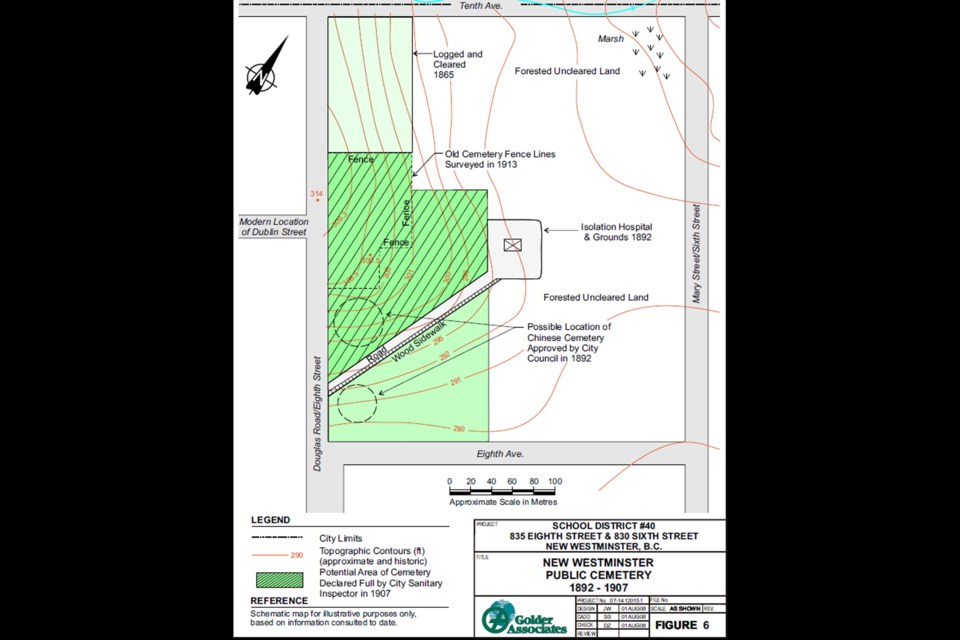A group that’s been an outspoken opponent of the New Westminster Secondary School replacement project is at it again, this time suggesting stakeholders have been misled about the location of the Chinese cemetery.
In a statement, the Canadians for Reconciliation Society, a Chinese Christian-based society that, according to its website, works to promote reconciliation with Canada’s indigenous peoples and to raise awareness of the histories of minority communities in B.C., accused the province of misleading the public about the location of the Chinese burial grounds at the former Douglas Road Cemetery – now the New Westminster Secondary School site.
Between 1860 and 1920, the cemetery was the final resting place for the poor, prisoners, stillborn babies and mentally ill patients from Woodlands and Essondale (Riverview). It was also used by the Sikh, First Nations and Chinese communities to inter their dead.
Bill Chu, CEO of the reconciliation society, claims that in a report on places of historical significance for the Chinese community, which was released by the province last year, a map outlining the Chinese cemetery on Douglas Road (now Eighth Street) is incorrect. Chu argues the map suggests the burial grounds used by the Chinese community was in the northwest corner of the site near the corner of 10th Avenue and Eighth Street when, before 1907, it was closer to Eighth Street and Eighth Avenue.
“I think it’s important to show the public that enough is enough,” Chu told the Record.
This Saturday, Chu is inviting members of the community to a “symbolic demonstration” starting at 10 a.m. The demonstration is meant to shine a light on the mistreatment of people of colour buried below the high school. People are encouraged to make crosses and headstones out of wood to plant in the lawn at Eighth Street and Eighth Avenue, near where the original Chinese cemetery was located.
“We need to provide them (the district) and the public with the facts,” he said.
Pat Duncan, superintendent of the New Westminster school district, admitted the map in the province’s report was incorrect, as Chu suggested, but said the district already knew the boundaries of the Chinese cemetery.
“It shows that the Chinese cemetery is at the top of 10th and Eighth and, in fact, it’s not, and we know that and we never said it was,” Duncan told the Record.
In a 2008 report by Golder Associates, commissioned by the school district, it’s noted that the Chinese portion of the cemetery occupied part of the southwest section of the cemetery prior to 1907, at which time the site was declared full. In 1909, the Chinese Benevolent Association leased two acres of land along 10th Avenue. The lease agreement was cancelled in 1914.
Today, the site is divided into two areas – the official cemetery site and the Heritage Conservation Act area. While official cemetery area, which encompasses most of the northwest corner of the high school site and a slight portion south of Dublin Street, was well-documented, the heritage site lacks information and documents required to earn official cemetery designation.
But that doesn’t mean the district has plans to raze the heritage site to build its new high school.
Duncan is adamant that no construction will take place on any known or possible burial grounds, no matter if they’re inside or outside of the official cemetery area. This means the sites identified by Golder as possible burial grounds used for the Chinese cemetery won’t be touched, Duncan added.
“We are absolutely, and so is the government, 100 per cent committed to making sure that we do not build on any known burial area,” he said.
Before 1907, the Douglas Road Cemetery operated without clearly defined burial plots. Bodies were buried haphazardly and sometimes less than four feet below ground. Missing documentation makes it nearly impossible for Golder and the school district to definitively say where the bodies were buried between 1861 and 1907.
Because of this, the district began exploratory work on the site this summer. It is conducting ground-penetrating radar scans of the heritage site. The information collected from the scans will be analyzed and any signs of human remains will be inspected through a dig. If remains are found, the district will ensure the area is protected from construction, according to Duncan.
The district has already declared some areas within the heritage site off-limits to the replacement project, including two small sections near the southwest corner of the site at Eighth Street and Eighth Avenue that were likely used as the Chinese cemetery prior to 1907.
“We’re not taking any chances; we will not be building the school in that area,” Duncan said.



